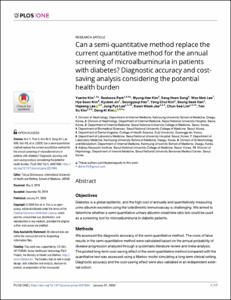KUMEL Repository
1. Journal Papers (연구논문)
1. School of Medicine (의과대학)
Dept. of Internal Medicine (내과학)
Can a semi-quantitative method replace the current quantitative method for the annual screening of microalbuminuria in patients with diabetes? Diagnostic accuracy and cost-saving analysis considering the potential health burden
- Keimyung Author(s)
- Kim, Yae Rim; Lee, Won Mok; Kim, Hye Soon; Jin, Kyu Bok; Han, Seung Yeup
- Journal Title
- PLoS One
- Issued Date
- 2020
- Volume
- 15
- Issue
- 1
- Abstract
- Objectives:
Diabetes is a global epidemic, and the high cost of annually and quantitatively measuring urine albumin excretion using the turbidimetric immunoassay is challenging. We aimed to determine whether a semi-quantitative urinary albumin-creatinine ratio test could be used as a screening tool for microalbuminuria in diabetic patients.
Methods:
We assessed the diagnostic accuracy of the semi-quantitative method. The costs of false results in the semi-quantitative method were calculated based on the annual probability of disease progression analyzed through a systematic literature review and meta-analysis. The pooled long-term cost-saving effect of the semi-quantitative method compared with the quantitative test was assessed using a Markov model simulating a long-term clinical setting. Diagnostic accuracy and the cost-saving effect were also validated in an independent external cohort.
Results:
Compared with the quantitative test, the semi-quantitative method had sensitivities of 93.5% and 81.3% and specificities of 61.4% and 63.1% in the overall sample of diabetic patients (n = 1,881) and in diabetic patients with eGFR ≥60 ml/min/1.73 m2 and a negative dipstick test (n = 1,110), respectively. After adjusting for direct and indirect medical costs, including the risk of disease progression, which was adjusted by the meta-analyzed hazard ratio for clinical outcomes, it was determined that using the semi-quantitative method could save 439.4 USD per person for 10 years. Even after adjusting the result to the external validation cohort, 339.6 USD could be saved for one diabetic patient for 10 years.
Conclusions:
The semi-quantitative method could be an appropriate screening tool for albuminuria in diabetic patients. Moreover, it can minimize the testing time and inconvenience and significantly reduce national health costs.
- Publisher
- School of Medicine (의과대학)
- Citation
- Yaerim Kim et al. (2020). Can a semi-quantitative method replace the current quantitative method for the annual screening of microalbuminuria in patients with diabetes? Diagnostic accuracy and cost-saving analysis considering the potential health burden. PLoS One, 15(1), e0227694–e0227694. doi: 10.1371/journal.pone.0227694
- Type
- Article
- ISSN
- 1932-6203
- Source
- https://journals.plos.org/plosone/article?id=10.1371/journal.pone.0227694
- 파일 목록
-
-
Download
 oak-2020-0149.pdf
기타 데이터 / 1.61 MB / Adobe PDF
oak-2020-0149.pdf
기타 데이터 / 1.61 MB / Adobe PDF
-
Items in Repository are protected by copyright, with all rights reserved, unless otherwise indicated.